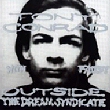|
|

Tony Conrad with Faust Time is irrelevant to Tony Conrad. Western, linear, causal time, that is. "Music is like history," he proclaims, "Always in the presnt." Conrad was the foundation of the notorious Theatre of Eternal Music, along with Fluxus composer/saxophonist LaMonte Young, calligrapher/artist Marian Zazeela, drummer/calendar-maker Angus MacLise, and future Velvet violist, John Cale. From 1962-1965 they scraped hipster brains and New York loft spaces out with their heavy, amplified drone, suspending notions of time altogether over the course of all-night concerts. Theirs was not only a music without end, taking months to get to the next note of the scale, but one that was of the ensemble mind, totally collaborative and without ego. No possible end of the drone, no definite boundaries of the group, so the thinking went. With the pedigree of strong personalities involved though, the group soon fractured, with Young taking compositional credit and suppressing the tapes, leaving both Conrad and Cale out in the cold. Only one ever managed to slip out of the "syndicate," an nth generation tape from 1965 called Day of Niagara, which was finally released in 2000, the first time anyone at large had heard this music. But wait! Before that, Tony Conrad made a solo recording of four-channel violin din in 1964, although that didn't come out until 1996, as the brain-blistering Four Violins. Then there was the box set of Early Minimalism that supposedly encompasses music composed in 1965, but that was recorded in 1996 too. And before that, there was his recording with Jim O'Rourke and Steve Albini, Slapping Pythagoras, which was released in 1995. Then there's his other first record, made with Krautrockers Faust providing accompaniment over a three day fling out in the German countryside. This was the one that was out on time, pithily named Outside the Dream Syndicate. And that may as well not come out at all in 1972, as it promptly fell without a trace 'tween the huge schisms of Pop and Classical deep into that black place outside of time, the cutout bins. Now it's back again for it's thirtieth anniversary, expanded into two CDs, with the originally released portions, "From the Side of Man and Womankind" and "From the Side of the Machine" on one disc, and the outtakes of the collaboration on the other. And whether you heard it in 1972, or the first time around on the earlier Table of the Elements CD reissue, or in the present time, it still kicks infinitely. At it's most basic, this an early fusion of the classical and avant-garde with the more rock and pop sensibilities of the day, something not seen since the Beatles' Stockhausen riff, "Revolution #9," and scarcely since. It couples the minimal tones that composers like Terry Riley and Steve Reich were already taking to the bank (they themselves purloining the concepts from TEM, who in fact assumed it from the untempered Indian scales and harmonic clusters) with an almost James Brown-like bass-kick bottom and relentless thrust. The results are prodigious, prophetic, powerful. "Man and Womankind" seems like it might never end, much less ever start, which is the point, presumably, of "eternal music." The initial 1-2 lockstep of the Faust rhythm section, Jean-Hervè Peron and "Zappi" Dermaier, seems like the most rigid and uptight base for the Almighty Drone, as opposed to the more fluid drumming of a Rashied Ali (with late, untethered Coltrane) or Angus MacLise (quite familiar with Conrad's soundfields). For new inductees, it can be Teutonic, tedious, oppressive. But as it pounds on, hat-tom, hat-tom, hat-tom-crash! (or is it tom-hat, tom-hat?) it plies itself, the bass and drumheads attuned to Conrad's tonic note. Five (or is it ten?) minutes in, it's all the rubbery pulse needed to buoy Conrad's just-intoned violin strings as he alternately sears and soars over them for twenty-seven minutes of pure, raw, thumping hum. To this day there's still nothing quite like its primitive, otherworldly chug. The highlight for me remains the loosened sprawl of "Machine." Here the trio is joined by Faust's own Phantom of the Opera, Rudolf Sosna, whose primitive synths vie with the amplified violin for the drone trophy. While Conrad boils resiny plumes of thick, resonant smoke, Sosna swirls silver strands of fog around each cloud, and all is obscured within it. Zappi pounds and rolls like unseen thunder, and Peron stomps like a giant inside it all. Their sympathies converge and together they elevate into endless crescendos and cascades of holy sound, floating on an Om-like soundwave, the unit hovering as one over the farm at Wümme, simultaneously clouding over the conscious mind and clearing out the third eye. Only available as a limited edition seven inch back in 1993, the little snippets of "Angus Was Buried in Kathmandu"/"The Death of the Composer was in 1962" are tasters only, with the long fangs of the violin scarcely given time to sink all the way in before they draw back out at the three minute mark. The complete version of "From the Side of Woman and Mankind," at thirty-one minutes, is four minutes longer than the previously released version. Astute ears will notice that it is merely an undubbed version of the "Man and Womankind" track, but with an extra half hour of that monolithic rock pulsation, most are unlikely to care. Whether an initiate or a first-timer, this is something quite timeless. Copyright © 2002 Andy Beta
|
| © 2011 Luna Kafé |